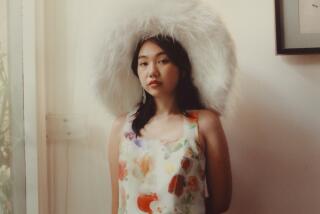FURNISHINGS : Floor Cloths Provide a Step Back in Time
- Share via
Tara Loughlin’s paintings are ripe with lush oranges, peaches and crimson pomegranates fit for a gilded frame. But her masterpieces are meant to be walked on, muddy boots and all. Her canvases are floor cloths, the poor man’s Oriental rug of the 18th and 19th centuries, and a favorite in Victorian decoration.
“People love the designs,” Loughlin says, “but they have a hard time with the concept. Walk on a painting? That unnerves them.”
And it has done so for centuries. Table carpets were common in the 17th Century, but it was not until the mid-18th Century that people began to move them off tables and onto floors as affordable rugs. Made of sturdy canvas or sailcloth and decorated with several coats of oil paint, floor cloths were easy to wipe clean and could take the hard knocks of snow and sand, mud and grass. Today’s floor cloths often are finished with polyurethane for greater durability.
“Floor cloths make so much sense for the way we live now,” Loughlin explains. “They’re handsome and indestructible.”
Floor cloths made sense nearly 300 years ago, too, when they were born of necessity. Floor carpets were virtually unknown until 1725, when some affluent Americans imported handmade Oriental rugs. Those who couldn’t afford the yearned-for “boughten” carpet sought alternatives. The floor cloth was the attractive option.
In America, floor cloths were made by professionals who also painted houses and signs. Upholsterers and paperhangers made them, too, or repainted worn or faded ones. The homeowner could choose among styles with a wide range of prices, or to be clever and economical could take a piece of canvas, nail it to the floor, and make one of his or her own.
Wealthier homeowners often imported floor cloths from England, using them as cooler summer replacements for rugs or to cover and protect their valuable wool pile or Oriental carpets. In 1796, President George Washington paid $14.82 for a floor cloth, and as late as 1827 a Boston company advertised painted floor cloths from “$1.27 1/2 to $2.25 per square yard.”
According to Thomas Jefferson’s 1861 inventory of furniture in the White House, floor cloths also adorned a dining room and an entrance at the President’s residence.
By mid-19th Century, a wide variety of machine-woven floor coverings were available. As more luxurious carpet became affordable, the utilitarian floor cloth began to lose favor.
Loughlin first read about floor cloths two decades ago, when there was a revival of interest in stenciling and decorative painting. “I was enchanted with the idea that it was a Victorian form of decoration, which I have always admired,” she says. Some of her floor cloths use motifs that were popular during that era, such as glossy and gilded garlands of fruit and foliage.
Often, unusual color combinations spark the ideas for Loughlin’s floor cloths. “Wrapping paper with two colors next to one another can trigger an idea,” she says. She sketches until she produces a tiny design that pleases her, which she then magnifies freehand to fit the canvas. She executes her design in oil or acrylic paints and protects the surface with coats of polyurethane.
Loughlin’s floor cloth business started small. “I needed to make a wedding present for a friend,” she says. “I had no money, but I had my art materials, so I painted a floor cloth, rolled it up and shipped it out.”
Until five years ago, Loughlin seriously pursued a career as a painter of canvases to hang on the wall. She made floor cloths only as presents for friends. When people took obvious delight in them, she turned her attention to cheerful, functional art. Her floor cloths sell by referrals and through the Cry of the Loon art gallery in South Casco, Maine. They run from $150 to $2,000, depending upon size.
Every day, Loughlin works in her 12-foot-square studio on Portland’s main street. Floor cloths in the making are stapled to the walls amid a profusion of sketches of new designs and splashes of test colors. “This studio is a happy place to come to,” Loughlin says. “Here I’m surrounded by happy colors and images, a feeling of nature in the middle of the city. I follow my imagination wherever it takes me.”


